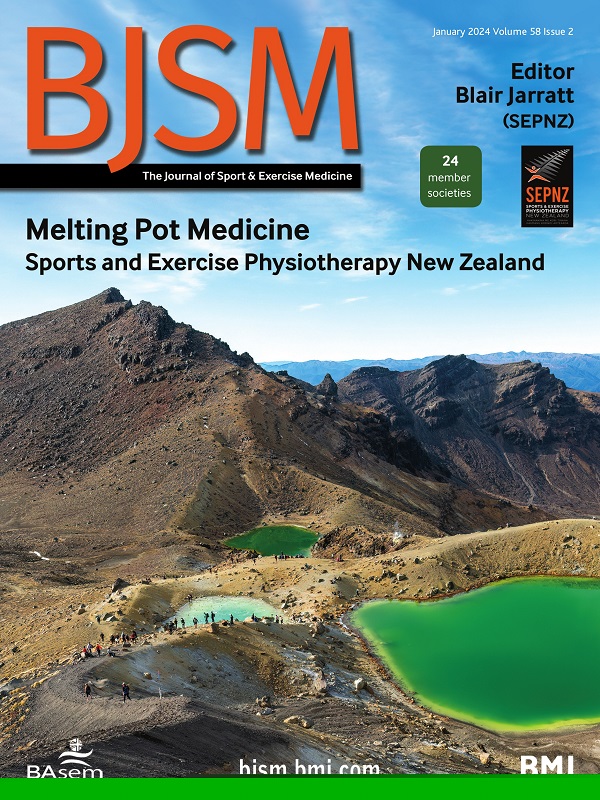盆腔器官脱垂与身体活动:未来的研究方向
IF 16.2
1区 医学
Q1 SPORT SCIENCES
引用次数: 0
摘要
骨盆器官脱垂(PoP)的全球患病率差异很大,但据估计,高达40%的女性在其一生中会经历某种程度的PoP。发生PoP的可能性随着年龄、多胎、肥胖、慢性咳嗽和某些职业或生活方式因素而增加患有脱垂的女性经常报告害怕从事体育活动(PA),因为担心这会加重症状或加速脱垂的进展调查显示,近三分之一的PoP女性认为她们的症状是运动的障碍,导致她们较少参加有组织的和娱乐性的PA。尽管存在这些担忧,但由于研究结果不一致,PA对PoP的影响尚不清楚。一些研究表明,高强度的运动可能会使症状恶化,而另一些研究则表明,适度运动没有关联,也没有潜在的好处。缺乏明确的指导导致许多妇女不必要地限制其PA,增加了久坐行为和相关合并症(如心血管疾病和骨质疏松症)的风险。此外,手术干预如网状植入物引入了额外的并发症,许多妇女经历慢性疼痛,进一步减少了PA的参与本次讨论的目的是强调以往研究中仍然存在的关键差距,这些差距限制了对PA和PoP之间关系的理解,并建议未来的研究方向,使妇女能够在……本文章由计算机程序翻译,如有差异,请以英文原文为准。
Pelvic organ prolapse and physical activity: directions for future research
The global prevalence of pelvic organ prolapse (PoP) varies widely, but it is estimated that up to 40% of women will experience some degree of PoP in their lifetime. The likelihood of developing PoP increases with age, multiparity, obesity, chronic cough and certain occupational or lifestyle factors.1 Women with PoP often report a fear of engaging in physical activity (PA), driven by concerns that it may exacerbate symptoms or accelerate prolapse progression.2 Surveys indicate that nearly one in three women with PoP cite their symptoms as a barrier to exercise, leading to reduced participation in both structured and recreational PA.2 3 Despite these concerns, the impact of PA on PoP remains unclear due to inconsistencies in research findings. Some studies suggest that high-impact activities may worsen symptoms, while others report no association or potential benefits of moderate exercise.4 5 The lack of definitive guidance leads many women to limit their PA unnecessarily, increasing the risk of sedentary behaviour and associated comorbidities such as cardiovascular disease and osteoporosis.4 5 Furthermore, surgical interventions such as mesh implants have introduced additional complications, with many women experiencing chronic pain that further reduces PA participation.6 The aim of this discussion is to highlight the key gaps that remain from previous research that limit understanding of the relationship between PA and PoP, and to recommend future research directions that are required to enable women to make informed decisions on …
求助全文
通过发布文献求助,成功后即可免费获取论文全文。
去求助
来源期刊
CiteScore
27.10
自引率
4.90%
发文量
217
审稿时长
3-8 weeks
期刊介绍:
The British Journal of Sports Medicine (BJSM) is a dynamic platform that presents groundbreaking research, thought-provoking reviews, and meaningful discussions on sport and exercise medicine. Our focus encompasses various clinically-relevant aspects such as physiotherapy, physical therapy, and rehabilitation. With an aim to foster innovation, education, and knowledge translation, we strive to bridge the gap between research and practical implementation in the field. Our multi-media approach, including web, print, video, and audio resources, along with our active presence on social media, connects a global community of healthcare professionals dedicated to treating active individuals.

 求助内容:
求助内容: 应助结果提醒方式:
应助结果提醒方式:


